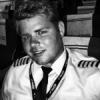First of all, the CRJ-200 does not have an autothrottle. Therefore, W/fT did not include an autothrottle in their CRJ. This will require a little more work but is much more fun (in my opinion, anyway)
The W/fT CRJ doesn't have little icons to click on the panel to bring up the other parts of the panel, instead use the SHIFT+1, SHIFT+2, etc.
Let's start:
When you load up FS and start with your variation of the CRJ (VC, 2D, etc.) and hit Fly Now! you'll be brought straight to the flight deck with running engines, APU's, the whole deal. I personally don't like just starting out with everything already set up for me, so I'll shut everything off before starting. If you decide to start out like this, then follow these steps:
1. Turn on the battery by clicking the BATTERY MASTER switch on the overhead.
2. You need to start the APU. So open up the overhead panel and first open the APU door by clicking PWR FUEL button in APU section. (It's in the middle) Now that the APU door is open you can go ahead and open the APU LCV by clicking the appropriate button in the 10th stage section. (Above the PWR FUEL button). You're supposed to also open the ISOL valve, but I find the button doesn't work on my model. The APU is ready to be started. Go ahead and click the START/STOP button next to the PWR FUEL. You'll notice on the main panel that the APU RPM will start spooling up. When it gets to 100% turn on the APU GEN switch in the electrical department.
3. You're ready to turn on the packs. Turn them both on, you'll know when they're on, they're loud and annoying.
4. Turn on all of your hydraulics, they can all be switched to AUTO after the APU has been started. Convienient....
5. Bring up the FMS. It will show the STATUS page, it should also say CHK POS in yellow at the bottom. Click the corresponding button next to POS INIT. Punch in the airport that you're at in the scratchpad and paste it in the AIRPORT section. This will bring up a latitude/longitude of where you're at. Down select the new lat/long that came up, and paste it back again in the SET POS section. Now the FMS knows where it is.
6. You're ready to input your route. Continute to the FPLN area. You'll see ORGIN and DEST. Guess what you'll put there? That's right. Put in the airport you're departing in the DEST and, well you get the picture on that. Click on the DEP/ARR button, and select the runway you're going to be taking off on. Go back to the FPLN page, and input the first waypoint in the TO section, and so on and so forth. The VIA section does not work. Once you're done with that continue to the PERF INIT page, and input how many passengers you're taking, the cargo, fuel, cruising altitude, etc. You're done with the FMS. If you plan on using the NAV feature, and have autopilot follow the track, press SHIFT+4, and scroll through on the NAV SOURCE wheel to select FMS, it will come up grey on the MFD. This is a common mistake and can be frustrating when the plane doesn't follow the track.
7. You can now start the engines. Turn off the packs before you start the engines. Make sure you have the parking brake on, the CRJ tends to creep forward even at idle. On the overhead click on IGNITION A, and then START for L ENGINE. On the throttles, when N2 reaches about 20%, right click on the thrust lever for the appropriate engine to burst it into life. Do the same for the other engine, too. After they're started turn the packs back on. On the glareshield, set your initial altitude and your speed. Make sure its fast enough. (duh!)
8. When you're ready for takeoff, make sure your trim is in the green area, (7.3+) and flaps at least 20. Also make sure you're N1 limit is set for T/O. (In the FMS PERF page) Once you've taken off, at 1,200 feet, turn OFF the 10th stage bleeds. (The ones on the far left and right). Hit the SPEED button on the glareshield, and turn on the autopilot. Since the CRJ has no autothrottle, the plane will pitch itself so that with the current throttle it will maintain this speed. Smart plane, huh? At 10,000 feet turn off the APU, you don't need it from here on up. But you will later. Set the autopilot, etc.
9. When cruising make sure the N1 limit is set to CRZ.
10. Descending is very simple and needs not explanation, although at 10,000 feet start the APU again.
11. The CRJ is easy to fly in visually, but maybe that isn't available. You need the ILS with the current weather. Follow the ATC's vectors. Bring up SHIFT+4 and select VOR1, or if you're in range and tuned to the ILS, LOC1 will come up in green. I usually enter the ILS 220 and under. Hit the APP and follow a routine ILS approach. Keep dropping some flaps and lowering the speed, watching it closely (200, 180, etc.) The CRJ likes 160 on final, then 140 with full flaps. The CRJ lands fast, around 140. It's a bit tricky landing without a bounce, very satisfying when you nail it. Don't over-pitch or you'll float, don't under-pitch or you'll smack it down. (obviously) At about 50 feet, drop it to idle and flare. Once the tires touch the runway the spoliers will automatically deploy, you're job is the reverse thrust. Clear the runway, turn off the neccessary lights, etc. Put down the spoilers and taxi in.
12. Turn off the engines, APU, etc.
Congratulations, you flew that like a pro. With practice you'll be an expert in no time. The CRJ is a beautiful plane, fun to fly and overall awesome!
Thank's for reading, hopefully it's of some use to some people.



















